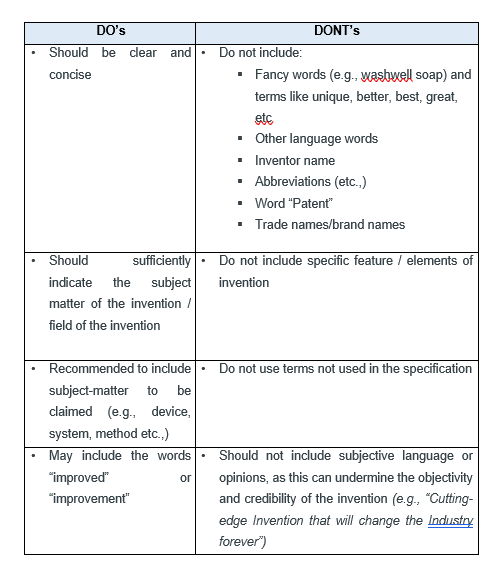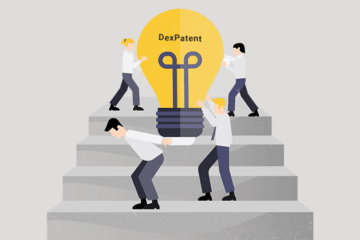Top 10 Tips and Techniques for Patent Drafting

A patent application provides a comprehensive description of an invention, its components or operation and the method by which it is assembled or performed.
To obtain a patent, it is necessary to draft a patent application that clearly discloses the entire concept of your invention. Patent application drafting plays a vital role in the patenting process. A well-drafted patent application can make the examination, prosecution and grant of the patent easier. Further, it is also useful for other stages like management and maintenance of a patent during its tenure, and turning it into a business model / commercial purpose.
The patent application should include a detailed description of the technical problems present in the existing prior art, as well as the solutions offered by the invention.
Anatomy / structure of patent application:
Let us first understand the basic outline of a patent application. A typical patent application will include the following sections:
- Title of invention;
- Field of invention;
- Background of invention with regard to the drawback associated with known art;
- Objectives of invention;
- Statement of invention;
- Summary of invention;
- Brief description of the accompanying drawing(s);
- Detailed description of the invention with reference to drawing/example(s);
- Claim(s); and
- Abstract
Pre-drafting preparations:
Prior to drafting the patent application, it is advisable to focus on the following points:
- Understand the given invention disclosure completely
- Identify the field of invention and the other possible applications for the invention
- Identify the problem, which is solved by the invention
- Explain the solution and illustrate it by way of an example
- Identify the related art and the difference with the present invention by doing a prior art search
- It is advisable to seek the assistance of a patent drafting professional or a patent agent to effectively navigate the intricate patent application process and to avoid common pitfalls that may result in the rejection or invalidation of the patent application
Essential tips for Patent Drafting:

Drafting a patent application is a skill that demands a high level of expertise in both technical understanding and language proficiency. Describing something new and non-obvious that never existed before is a challenging task. The success of obtaining a patent for an invention relies heavily on the innovation of the invention itself and the quality of the patent application draft. Hence, it is crucial to approach patent drafting with meticulous attention and care.
Here are some helpful tips for drafting the various sections of a patent application, that will enable you to create a clear and concise application:
# 1: Title of the invention:
A title should reflect the main subject art of the invention as it contributes to overall success of the patent application. It should be precise, meaningful and should be normally within 10 to 15 words (7 words for international application). Same title can be used for more than one invention. Here are some do’s and don’ts to consider when crafting the title of an invention:

# 2: Field of invention:
Field of invention generally describes the subject matter to which the invention relates, its advantages, preferable use, areas of application, and the scope of the invention. It serves as a concise overview of the invention while providing a description of the specific technology area to which the invention belongs. A field of invention may include the areas of application and use of the invention. So, basically, a field of invention should be drafted such that the Examiner of patent application easily understands the nature of the invention and is able to classify the based on its technology.
# 3: Background of the invention:
A background should cover the need for the invention and should explain the technical area behind the invention. The background should describe the problem that invention tries to solve or should elaborate the limitations / disadvantages accompanying the solutions provided in the prior art. It is better to avoid the use of terms “prior art”, “invention” in background section.
A background may cover the existing references / prior art (obtained through prior art search) to differentiate the present invention by highlighting limitations of prior art. Avoid using derogatory statements about existing art or using offensive or insulting language when referring to the prior art in the patent application.
While it is crucial to provide sufficient detail in the background section, it should be concise and focussed. The primary objective is to provide the necessary context for the invention without overwhelming the reader with excessive or unnecessary information.
# 4: Objectives/objects of invention:
Mention what the invention aims to achieve by listing out as advantages of the present invention. It should describe the solution of the existing technical problem associated with the existing field. An objective must not include drawbacks of the prior art. Avoid describing the narrow objectives of the invention as they can limit the scope of invention. Also, avoid use of conflicting terms while drafting objectives of the invention. Each and every objective / advantage of the invention should be described in a separate sentence. Basically, this section should present a comparative analysis of the inventive technology over the existing one.
# 5: Statement of invention:
Statement of invention describes the exact novel features of the invention. It should clearly highlight the inventive features of the invention over the existing prior art. It should briefly and evidently summarize the invention by including all elements or essential features of the invention / product / machine. Statement of invention is helpful in stating the inventiveness of the invention and also link exactly with the independent claims which will define clearly exclusive right required in case of infringement proceedings.
# 6: Summary of invention:
Summary of invention presents a broad overview of the invention in summarized form. A summary should describe the invention as a non-legal form of broadest independent claim(s). It should describe the exact nature, operation, and purpose of the invention. A summary shall also include preferred embodiment(s) of the invention. The summary helps to understand the detailed description of the invention / drawings and claims of the specification. The solutions to the problems described in background section can be described in summary. The summary should not include drawbacks of the prior art.
# 7: Brief description of drawings:
The brief description of drawings includes a written description of the invention, accompanied by illustrative drawings that aid in understanding the invention’s features and functionality. It should include specific and uniform reference numerals that correspond to the elements depicted in the drawings. These reference numerals help in clearly identifying and referring to the different components or elements of the invention throughout the description. A drawing should not include dimensions and descriptive matter. The drawings should be illustrated in such a manner that enables a person skilled in the relevant field or art to understand and replicate the invention.
# 8: Detailed description of the invention:
A detailed description of invention starts with an overview of an invention and then describes in detail what the invention is, how it is made and used. A detailed description should describe all the embodiments starting with the preferred embodiment. It should also include explanation of figures wherever necessary. It should describe one element at a time and include all the details / examples for the element before moving to the next element. A detailed description shall end with a conclusion describing the advantages of the invention.
The primary purpose of the detailed description is to provide sufficient information to a person with expertise in the relevant field so that they can implement the invention without requiring additional experimentation. Therefore, it is necessary to present a comprehensive overview of the invention.
Provide a thorough and comprehensive description of the apparatus, system, or device, along with illustrative drawings (referring to the drawings) that clearly show each component and its interconnections. Also, describe the optimal method for carrying out the invention in detail.
# 9: Claims:
The most critical part of a patent application is the patent claims. Claims are often considered as the heart of the patent application, as the legal protection granted by a patent is based on the claims, and it is the claims that define the exclusive rights granted to the inventor. Patent claims provide the right to exclude others from making, using, and selling the invention that is specifically claimed. A claim should be:
- Clear and concise for defining the scope of invention.
- Related to a single invention or to a group of inventions linked so as to form a single inventive concept.
- Supported by the description.
- Start a fresh page for the claims section in the patent application. It should be serially numbered. Each claim in a patent application should start as a new sentence.
A claim shall contain three parts, namely: preamble, transitional or linking phrase and body of the claim.
Preamble / Introductory phrase identifies the category of the invention and sometimes the purpose. One should keep the preamble of the claim as broad as possible by adding generalization. Example: In a preamble, instead of giving “An improved LCD television transmitter” you can give “An improved television transmitter”.
The transition phrase is the word or phrase which links the preamble and the claim body. The typical transition phrase used are comprising, consisting etc. These words define the limitation for scope. The use of term “comprising” provides space for adding one or more elements in the claim(s) while “consisting” narrows the scope and restricts the addition of new elements to be added, if any.
An independent claim should be broad and include minimum number of elements. Body of the independent claims shall include only the main elements of the invention i.e., elements that are required for the functioning of the novel features. The independent claim should not include all the elements mentioned in the information disclosure. Every element included in the independent claim becomes the essential element to implement the invention and limits the scope of the claim. Order of the claims should be based on the functionality.
A dependent claim adds limitation to the independent claim. It can introduce new components to the independent claim. A dependent claim should be narrow and cannot omit / modify / substitute the features of the independent claim.
One should use correct antecedent basis for the elements on claim. In the claim, when an element introduced for the first time, you should use indefinite article “a” or “an” and when the introduced elements are referred back to the previous claims, then you should use definite article “the” or “said”.
# 10: Abstract:
Abstract provides the brief technical information about the invention that are consistent with the broadest claim. Abstract should be drafted within 100-150 words on a fresh page. Abstract is primarily used for searching patents, so it should be drafted with at most care. An abstract shall refer to appropriate figures (along with reference numerals, if any) corresponding to the description of the abstract. It can include advantages, the solution proposed and preferred mode of working of the invention.
Key Takeaways:
To summarize, a patent draft or specification should identify the existing issue in the current state of technology or art and offer a new and non-obvious solution to someone skilled in the relevant field.
It is crucial to present the invention in a written format and ensure that it meets all statutory requirements to expedite the prosecution process. The written specification is usually the deciding factor for the grant of a patent, as the examiner typically does not request a model or prototype of the invention. Therefore, the patent draft should provide a comprehensive and detailed description of the invention, so as to enable someone skilled in the relevant field to implement the invention with minimalistic effort.
Patent drafting experts, excel at both communicating the broad concepts of your technology and implementing the techno-legal aspects of your invention that truly stand-out in your patent grant journey.












0 Comments